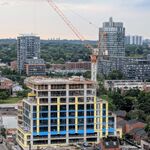Isn't that a little hard to believe?
Lets do this from the other side. Assume that rush periods offset 1am periods and lets do a calculation of riders on a train during the afternoon.
A train takes about 1 hour to complete a Finch to Downsview run at 2pm. Exactly one hour is a convenient time and good enough for an approximation. Off-peak loading standard is about 400 people per train and some level of churn will occur. In fact, 100% churn, at a minimum, occurs during the downtown section.
Lets assume 300 people between Finch and Union with 30% churn (some get off an Eglinton and others get on, etc); so 390 people in total. Ignore Bloor because it is paid for (transfer from another manned subway system).
Lets take 200 out of downtown to Downsview with 20% churn (240 people).
So, 630 people over an hour contribute a portion of their fare to cover the driver and doorman. Driver + Doorman cost $100 per hour between the two of them. ($30 take home and $20 in employee overhead)
In the middle of the afternoon on a train with empty seats going into and out of downtown, we get 16 cents.
Rush hour is closer to 1800 people on the train at any point during its trip, or 5.5 cents for driver + doorman.
1am is probably closer to 200 people on the train at any point during its trip, or 50 cents per passenger for driver + doorman. Lots more rush-hour trains than midnight trains though (over double) so I expect it balances out to something similar to the afternoon.
So I get 12 cents from one direction and about 16 cents from the other.
I think it is fare to say the upper limit (given wide margins for error in my estimates from selecting convenient numbers) it is between 6 and 25 cents per passenger and probably somewhere in the middle (12 to 16).
Higher churn or capacity per train pushes the value down. Lower churn or reduced passenger count per train pushes it up. Line delays push significantly higher. The Bloor dwell time reduction initiative pushes it lower as do Toronto Rockets coming online. So, SRT and Sheppard will be higher but Bloor line has higher churn than Yonge/Spadina so it may be lower.
You can tease a real number from the stats as they give actual train counts, actual running times, and approximate passenger counts for all lines. Add in a spare ratio for staff (breaks, sickness, etc.) and use a reasonable hourly salary (65,000/year without overtime) and overhead (2/3rds hourly wage).
Significant overtime for Employee A to reach $120,000/year means employee Z doesn't exist.
I'm pretty happy with my thumbsuck estimate though so I will not be doing this.




